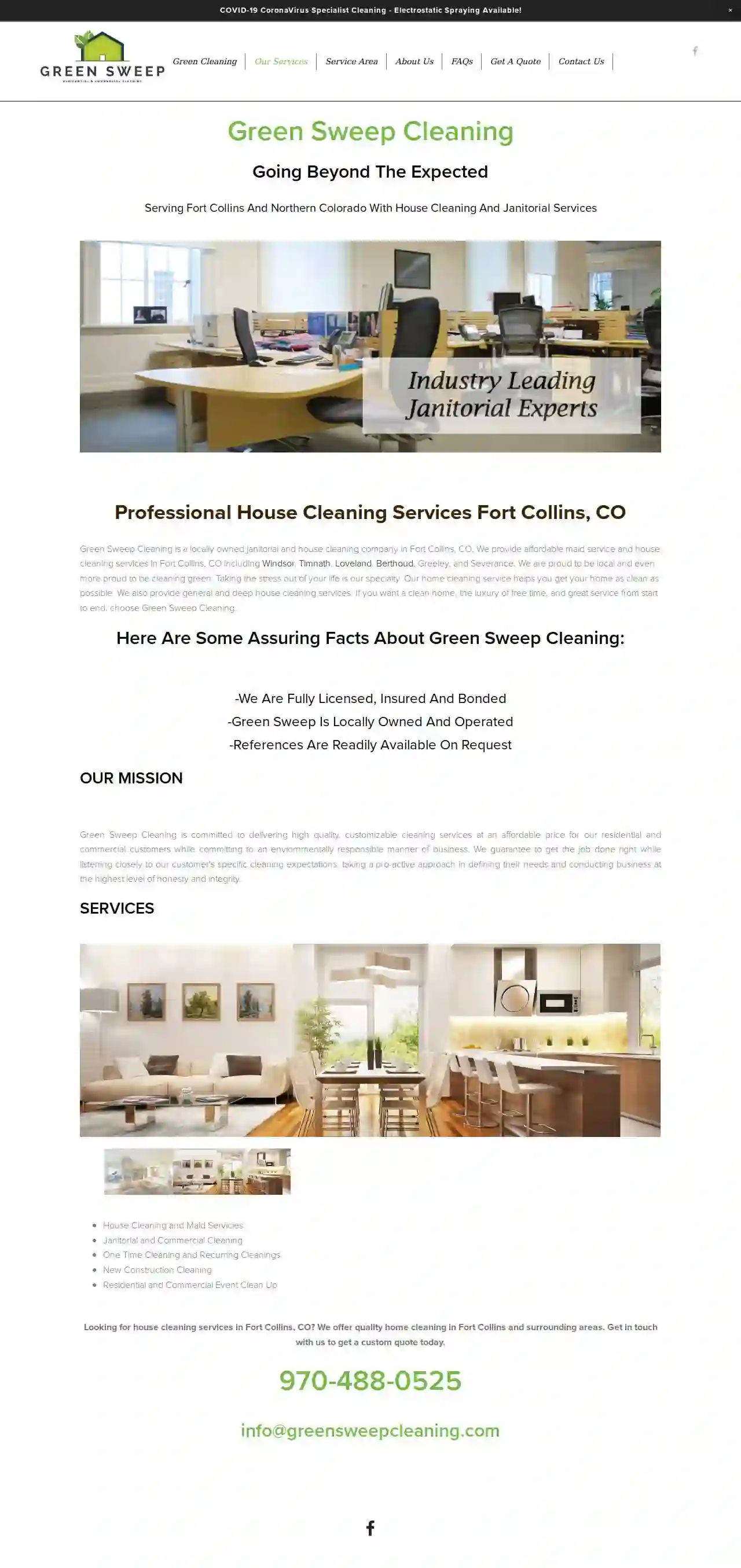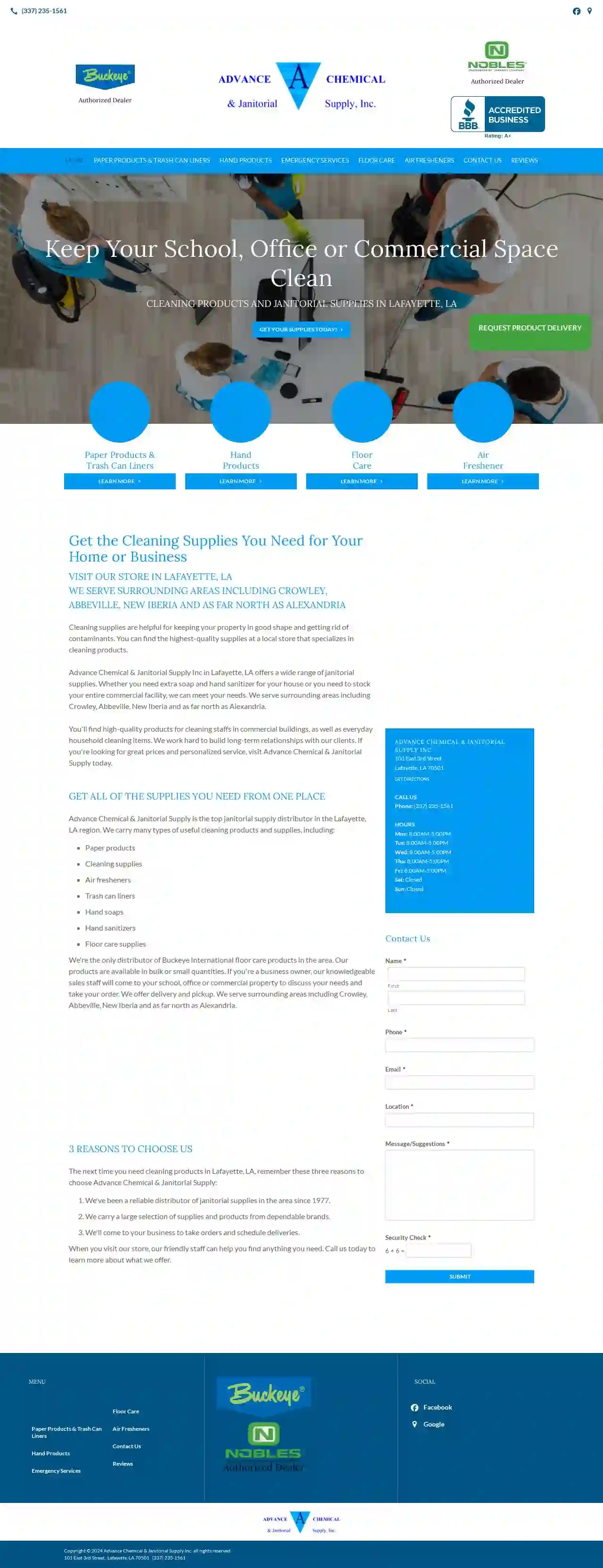Cleaning Services Woodland Park
Top Apartment Cleaning in Woodland Park
Receive 3 FREE Cleaning quotes for your project today! Compare profiles, reviews, accreditations, portfolio, etc... and choose the best service.

3aclean
4.58 reviewsDenver, US- Services
- Why Us?
- Gallery
Get Quote
Angel Touch Commercial Cleaning
4.748 reviewsDenver, USAngel Touch Commercial Cleaning is a local family-owned professional cleaning company. Along with our sister company, pūr matter high dusting, we provide customized office cleaning, window cleaning, carpet cleaning and high dusting services that will be appropriate for your specific needs throughout the entire state of Colorado. We make your office shine so you can shine too.
- Services
- Why Us?
- Accreditations
- Testimonials
- Gallery
Get Quote
ServiceMaster Action Cleaning
4.318 reviewsLafayette, US- Services
- Why Us?
- Gallery
Get Quote
Denver Janitorial
514 reviews3251 W Hampden Ave, Englewood, 80110, USDenver Janitorial is a local commercial cleaning company serving the Denver metro area from Englewood, Colorado. Our company offers customized commercial janitorial services to provide you with a personalized program that meets your business cleaning needs. Our janitorial programs include (but are not limited to) office cleaning, carpet cleaning, and window cleaning using environmentally-friendly products. Our company is here to provide you with a healthy and clean business environment for your employees and customers. Work with Denver Janitorial for services that will keep your business looking its best.
- Services
- Why Us?
- Accreditations
- Testimonials
- Gallery
Get Quote
Facility Cleaning International
2.65 reviewsDenver, US- Services
- Why Us?
- Gallery
Get Quote
ServiceMaster
4.69 reviewsDenver, US- Services
- Why Us?
- Gallery
Get Quote
Clean Sweep Janitorial Services
Gonzales, LA, P.O. Box 1832, 70707, USAt Clean Sweep Janitorial Services, our focus is on keeping corporate spaces professional with qualified cleaning services. As a janitorial company, we understand that upholding your reputation includes making great first impressions. Your company's interior sends a powerful message to potential clients. It is important to invest in a cleaning team that can ensure your business stays looking its best at all times. That is what we are here to accomplish. Our company specializes in commercial janitorial services that range from floor management to trash removal and more. We do not require contracts because we believe our work is what promotes lasting business relationships.
- Services
- Why Us?
- Testimonials
- Gallery
Get Quote- St
Stratus Building Solutions
530 reviewsLafayette, US- Services
- Why Us?
Get Quote 
Green Sweep Cleaning & Maintenance
3.919 reviewsDenver, US- Services
- Why Us?
Get Quote
Advance Chemical & Janitorial Supply Inc
4.722 reviewsLafayette, US- Services
- Why Us?
Get Quote
Over 60,241+ Janitorial Businesses on our platform
Our janitorial services operate in Woodland Park and surrounding areas!
CleaningMatch has curated and vetted Top Janitorial Services arround Woodland Park. Find a reliable pro today.
Frequently Asked Questions About Cleaning Services
- Prepare the Windows: Remove dust and debris from windows using a brush, vacuum, or damp cloth.
- Cleaning Solution: Use a commercial glass cleaner or a homemade solution of equal parts water and vinegar.
- Spray and Wipe: Spray the cleaning solution onto the window, ensuring even coverage.
- Squeegee Technique: Use a squeegee to wipe the cleaner from top to bottom, overlapping each stroke by about an inch. Wipe the squeegee blade clean after each stroke.
- Dry Edges: Wipe the edges of the window with a clean, dry microfiber cloth to remove any remaining moisture.
- Ventilation: Improve ventilation by opening windows, turning on the exhaust fan, and using a dehumidifier to reduce moisture levels.
- Bleach Solution: Mix one cup of bleach with one gallon of water. Wear gloves and eye protection when handling bleach. Apply the solution to the affected area, let it sit for 10-15 minutes, then scrub with a brush and rinse thoroughly.
- Vinegar Solution: For a milder alternative, mix equal parts water and vinegar. Apply to the moldy area, let it sit for an hour, then scrub and rinse.
- Baking Soda Paste: Make a paste of baking soda and water, apply to the moldy area, let it dry, then scrub and rinse. Baking soda helps remove stains and deodorize.
- Commercial Mold and Mildew Remover: Use a commercial mold and mildew remover according to the product instructions.
- Check Fabric Care Label: Always check the upholstery care label for cleaning instructions specific to the fabric. Some fabrics may require professional cleaning.
- Vacuum: Vacuum the upholstery thoroughly to remove dust and loose debris. Use a brush attachment for crevices and seams.
- Spot Cleaning: For stains, blot with a clean cloth or sponge. Avoid rubbing, as it can spread the stain. Use a mild upholstery cleaner or a homemade solution of water and mild dish soap.
- Upholstery Cleaning Machine: If the fabric is suitable for wet cleaning, you can use an upholstery cleaning machine. Follow the machine's instructions carefully and test a small, hidden area first.
- Professional Upholstery Cleaning: For delicate fabrics, deep cleaning, or stubborn stains, consider hiring a professional upholstery cleaning service. They have specialized knowledge and equipment to clean upholstery safely and effectively.
- Cleaning: Removing dirt, dust, and debris from surfaces using soap or detergent and water. It improves the appearance and removes visible contaminants.
- Sanitizing: Reducing the number of bacteria on surfaces to a safe level. It uses chemical disinfectants or heat to kill or inactivate bacteria.
- Disinfecting: Killing or inactivating most disease-causing microorganisms on surfaces. It uses stronger chemical disinfectants than sanitizing and targets a wider range of pathogens.
What is the best way to clean windows without streaks?
For best results, clean windows on a cloudy day or in the shade to prevent the cleaning solution from drying too quickly and leaving streaks.
How do I remove mold and mildew from my bathroom?
Always test any cleaning solution on a small, inconspicuous area first. After cleaning, take steps to prevent future mold growth by addressing moisture issues, such as fixing leaks and improving ventilation.
How do I clean upholstery without damaging the fabric?
Always test any cleaning solution on a small, inconspicuous area first to avoid discoloration or damage.
What is the difference between cleaning, sanitizing, and disinfecting?
Cleaning is usually the first step, followed by sanitizing or disinfecting depending on the level of hygiene required.
What is the best way to clean windows without streaks?
- Prepare the Windows: Remove dust and debris from windows using a brush, vacuum, or damp cloth.
- Cleaning Solution: Use a commercial glass cleaner or a homemade solution of equal parts water and vinegar.
- Spray and Wipe: Spray the cleaning solution onto the window, ensuring even coverage.
- Squeegee Technique: Use a squeegee to wipe the cleaner from top to bottom, overlapping each stroke by about an inch. Wipe the squeegee blade clean after each stroke.
- Dry Edges: Wipe the edges of the window with a clean, dry microfiber cloth to remove any remaining moisture.
For best results, clean windows on a cloudy day or in the shade to prevent the cleaning solution from drying too quickly and leaving streaks.
How do I remove mold and mildew from my bathroom?
- Ventilation: Improve ventilation by opening windows, turning on the exhaust fan, and using a dehumidifier to reduce moisture levels.
- Bleach Solution: Mix one cup of bleach with one gallon of water. Wear gloves and eye protection when handling bleach. Apply the solution to the affected area, let it sit for 10-15 minutes, then scrub with a brush and rinse thoroughly.
- Vinegar Solution: For a milder alternative, mix equal parts water and vinegar. Apply to the moldy area, let it sit for an hour, then scrub and rinse.
- Baking Soda Paste: Make a paste of baking soda and water, apply to the moldy area, let it dry, then scrub and rinse. Baking soda helps remove stains and deodorize.
- Commercial Mold and Mildew Remover: Use a commercial mold and mildew remover according to the product instructions.
Always test any cleaning solution on a small, inconspicuous area first. After cleaning, take steps to prevent future mold growth by addressing moisture issues, such as fixing leaks and improving ventilation.
How do I clean upholstery without damaging the fabric?
- Check Fabric Care Label: Always check the upholstery care label for cleaning instructions specific to the fabric. Some fabrics may require professional cleaning.
- Vacuum: Vacuum the upholstery thoroughly to remove dust and loose debris. Use a brush attachment for crevices and seams.
- Spot Cleaning: For stains, blot with a clean cloth or sponge. Avoid rubbing, as it can spread the stain. Use a mild upholstery cleaner or a homemade solution of water and mild dish soap.
- Upholstery Cleaning Machine: If the fabric is suitable for wet cleaning, you can use an upholstery cleaning machine. Follow the machine's instructions carefully and test a small, hidden area first.
- Professional Upholstery Cleaning: For delicate fabrics, deep cleaning, or stubborn stains, consider hiring a professional upholstery cleaning service. They have specialized knowledge and equipment to clean upholstery safely and effectively.
Always test any cleaning solution on a small, inconspicuous area first to avoid discoloration or damage.
What is the difference between cleaning, sanitizing, and disinfecting?
- Cleaning: Removing dirt, dust, and debris from surfaces using soap or detergent and water. It improves the appearance and removes visible contaminants.
- Sanitizing: Reducing the number of bacteria on surfaces to a safe level. It uses chemical disinfectants or heat to kill or inactivate bacteria.
- Disinfecting: Killing or inactivating most disease-causing microorganisms on surfaces. It uses stronger chemical disinfectants than sanitizing and targets a wider range of pathogens.
Cleaning is usually the first step, followed by sanitizing or disinfecting depending on the level of hygiene required.